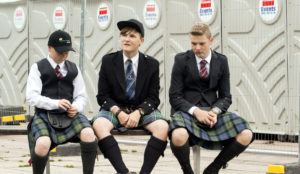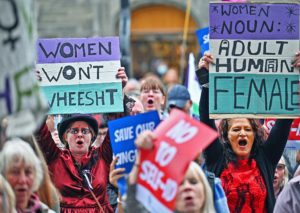The SNP’s triumph in last week’s Scottish elections came as no surprise: it was the party’s 11th election victory in a row. Instead, it was the downfall of the Scottish Tories and resurgence of Scottish Labour in second place that made headlines. Yet while Labour certainly did regain ground in Scotland, to the extent that it is now the primary opposition to the SNP, its victory isn’t all it’s been cracked up to be.
In reality, the party’s 20-seat gain was very modest, under-shooting prediction models and tying with the Lib Dems, while falling behind the SNP, who were not expected to make any gains. Scottish Labour leader Anas Sarwar may believe that “Scottish Labour is back“, but his party recorded its second-worst local result in half a century.
Meanwhile, the Scottish Tories have lost a staggering 63 seats. No doubt they will be shouting from the rooftops that it’s all because of Partygate and Douglas Ross’s humiliating U-turn on his call for Boris Johnson to resign over it. But the Conservative result is not as bad as it looks: in terms of seat pluralities, the Tories have placed first in five local authorities, ahead of Labour in three. They’ve also made gains in a few strategic areas such as Moray, Aberdeenshire and Ayrshire.
Nonetheless, there is little room for complacency. The Scottish Tories’ popularity appears to have reached a peak in 2017 in the wake of the Ruth Davidson surge and a fierce unionist backlash against Sturgeon’s plans for a second independence referendum. It has declined in the five years since, and the party’s current vote share of 19.6% will only fall further in a national election for Westminster or Holyrood, where far larger numbers of younger, working class and urban voters will turn out. And of course, the leadership and macroeconomic problems that dogged the Tories across Britain (where their net loss of 487 seats far outstripped the worst expectations) are only set to get worse.
Despite its underwhelming victory, Scottish Labour’s reclamation of the second place mantle matters symbolically — the SNP’s preferred opponents are Tories, who give them the opportunity to define themselves against unpopular Westminster rule. Scottish Labour coming back from the dead would therefore complicate the SNP’s monopoly on the centre-left, even if there’s reason to believe Anas Sarwar has learnt little from the failures of the Jim Murphy era, if his current insistence that no local government Labour groups cooperate with the SNP is anything to go by.
What does this mean for the fate of the independence movement? There has been talk of the issue being forced onto the back foot by the war in Ukraine and the cost-of-living crisis. Yet these developments only seem to have had a marginal impact on polling, which has hovered between 50-50 and 47 Yes – 53 No. In fact, if anything this election is further proof that the Scottish electorate increasingly favour independence. The vote-share of pro-independence parties was around 45%, while that of pro-union parties amounted to 55%. That’s quite a change from 2017, when 40% of votes were for pro-independence parties compared to 60% for unionist ones — especially when one takes into account that voters in local elections are more likely to be older, more middle-class and unionist compared to national elections.
Just after the election, a Panelbase survey for the Sunday Times found that more than 55% of Scots want an independence referendum to be held within this parliamentary term. Since the vote, senior Scottish Conservative grandees have said that opposition to Indyref2 is no longer working on the doorstep. The party’s former head of communications has openly acknowledged that the issue of the SNP dominance won’t be solved until a referendum is held. If this was meant to be an election for Scots to send Sturgeon a “no to Indyref2” message, it certainly doesn’t seem to have been interpreted by unionist parties in that way, to say nothing of voters themselves.
Interestingly, however, this hasn’t necessarily translated into support for the SNP. In places such as Edinburgh and Glasgow, it certainly appears that progressive and younger SNP voters are decamping to the pro-independence Greens over a variety of issues such as climate and social policy. That isn’t to say we should downplay the SNP’s performance: another insufficiently discussed consequence of the local elections is that council composition will be quite different now — and in the favour of nationalists. Previously, the SNP were only part of administrations in 14 local authorities around the country, but now it is well-placed to form as many as 25.
In practice, this could make all the difference when it comes to Indyref2. Should the impasse between Bute House and Downing Street end up with an emboldened Scottish Government pursuing an independence referendum outside the Section 30 framework laid out by the 2012 Edinburgh Agreement, it will in large part rely upon the cooperation of local authorities in being able to organise polling stations, counters and observers. While previously the largely unionist composition of many administrations would have been a bulwark against this, the strategic gains of the SNP and Greens across the board will make it significantly easier for a unilateral referendum to be held.
Still, if there’s one thing that did emerge as a pattern from the local elections, it was that there isn’t a pattern. This is by far the most fragmented election Scotland has seen in a long time. The SNP’s gains were highly uneven and scattered, as were the gains of Scottish Labour and Scottish Conservative’s losses. This is a continuation of the dynamic at last year’s Holyrood elections, where a “national environment” couldn’t really be said to exist because every individual constituency became a hyperlocalised contest between the SNP and whichever unionist party was best placed to challenge it.
In this regard, the local elections are best understood as a microcosm of Scottish politics as a whole: it was a grinding war of attrition where significant developments take place on both sides, but where the momentum continues to be on the side of nationalism.
Disclaimer
Some of the posts we share are controversial and we do not necessarily agree with them in the whole extend. Sometimes we agree with the content or part of it but we do not agree with the narration or language. Nevertheless we find them somehow interesting, valuable and/or informative or we share them, because we strongly believe in freedom of speech, free press and journalism. We strongly encourage you to have a critical approach to all the content, do your own research and analysis to build your own opinion.
We would be glad to have your feedback.
Source: UnHerd Read the original article here: https://unherd.com




